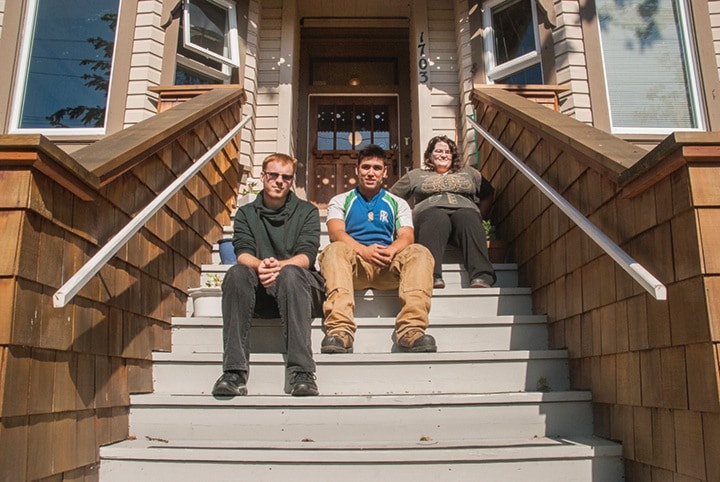There's a certain assumed stigma associated with homelessness. Many people think of drug addicts and aggressive panhandlers, but the people who walk through the doors of Threshold Housing Society know that's not an entirely accurate picture of homelessness in Greater Victoria.
Graham Webber is 21. He was living on his own in Sooke after his mom passed away. Admittedly lacking certain life skills, after six months he decided to look for a place to live that felt like home and where he could build up that skill set.
"It was really lonely living by myself," he said. "My social worker suggested that I come and check out Mitchell House, and it sounded really awesome. I wanted to live somewhere where I could get help with things like cooking because I didn't know how to cook. And being around lots of people with lots of support was good."
Katherine Crane is also 21. Having spent her childhood in foster homes, she was on the verge of being aged out of care at 19 years old, with essentially no other housing options available.
"Most of our youth right now are on the cusp of being aged out of care," said Mark Muldoon, executive director of Threshold, which operates Mitchell House and Holly House, two low-rent homes that provide nine beds total to youth who are at-risk of homelessness in Greater Victoria. "Out of all the kids in foster care who are aged out at 19, half will end up on the street in two years. It's an unseen, unrecognized, unacknowledged crisis going on."
There are only 17 beds total in all of Greater Victoria that provide a place for youth, but Muldoon says that number isn't nearly meeting the demand.
"For Mitchell House we had 60 referrals last year, and 37 referrals for girls. The demand outweighs supply by a huge margin," he says. "And why has this happened? The general public will just put the youth homeless population and adult homeless population together thinking everyone's taken care of by (the other service providers), but youth under 19 can't go for a meal at Our Place and can't stay at the shelters."
Youth that are lucky enough to get a bed at either Mitchell or Holly House say it's truly a life-changing place to live.
"I grew to be more comfortable. I wasn't really outgoing or extroverted, but I'm not as panicky anymore, I guess. I'm really sarcastic and can be really bitter, but I've lightened up a fair bit since (I first arrived)," said Crane, who stayed at Holly House for nearly two years before transitioning to Threshold's supported independent living SHY Program (Safe Housing for Youth). "Because of all the help from Holly House, I'm better equipped to deal with the world."
Youth in the Threshold's programming take part in self worth classes, to help build life skills by focusing on self worth and self care.
"We want them to start making better decisions about health, hygiene, jobs, finish school," Muldoon said. "We find these youth don't want a hand out, they want a hand up, and they want to prove themselves and get ahead in life."
The average length of stay for a youth in the semi-independent Mitchell or Holly House is 8.5 months for boys, and five months for girls, though Muldoon says some stay for a couple of years before being ready to transition into the SHY Program or move out on their own.
"SHY is very similar to Holly House, but it's a little more hands off," Crane says about her new living situation. "Like when you're learning to ride a bike, Holly House is when your parents is still holding onto the back and you've got training wheels, and then the SHY Program is just training wheels but your parents have let go."
Muldoon says Threshold is so appreciative of the community support they receive, and says that support pays off; ignoring youth homeless population today simply means they'll grow into the adult homeless population.
The Home Depot is currently raising money nationwide through The Orange Door Project to help reduce youth homelessness. Money donated through the purchase of a $2 paper orange door at the Shelbourne Street and Millstream Road stores goes to Threshold Housing Society.
"This is a great opportunity for us to give back to our community. Last year alone we raised over $8,000, and over $4,500 at the Langford location, said Tobin Fearon, store manager of The Home Depot in Saanich. "We feel that Threshold is an excellent organization that really supports the community. What's really nice about the campaign is every store is given the opportunity to choose a local charity, so this money is really getting to the people that matter the most to our store."
"Youth don't want to become stigmatized; a lot of the youth will not self identify as homeless because they want to be seen as normal," Muldoon said. "These are youth who are really paralyzed out of fear of not knowing where they're going to live. Our attempt is to make them included in a community and build life skills. We give them a home, get them stabilized and prepare them for a better life."
The Orange Door Project runs until July 2.
To learn more about Threshold Housing Society, visit thresholdhousing.ca.
